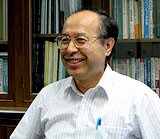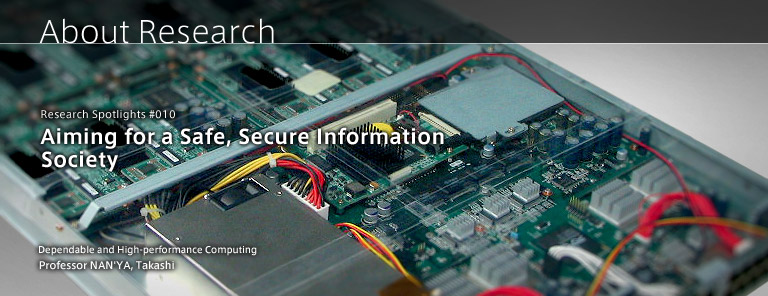The information society is progressing rapidly and certainly. While people have it easy, we need to make a dependable system they feel secure with and can rely on. That is the image of the future society for which we strive. Nowadays, when assets, privacy, and even people's lives are organized into information systems networks, there are three threats that hinder dependability.
The Three Threats that Hinder the Reliability of Information Systems
The first is the miniaturization of LSI(Large-scale integration). As the degree of integration gets higher and higher, transistors are increasingly miniaturized, and the smallest processed size is about the same as the influenza virus. When that happens, the reliability of the manufacturing process decreases, and the probability of all the transistors on the chip working normally decreases. Even when they do work, their characteristics do not become uniform and cause dispersion. Because of that, fluctuation phenomena cannot be avoided. When a synchronized signal called the clock (which arranges the timing everywhere on the chip and makes it operate) fluctuates and becomes unstable, it causes errors, and situations without clear causes can occur. In addition, resistance to outside interference, like minute particles from space and electromagnetic waves, becomes weaker. Intel in the U.S. had attempted to increase the frequency of the clock, but excess heat became a problem, and it abandoned its pursuit of higher speeds.
In an asynchronized system design, we would try to remove the clock if it is a hindrance. In this fashion we could extend the system's performance limits. Of course, the theoretical physical limits of atomic and molecular size still exist, but I am researching asynchronized systems, which depart from the industrial limits where Intel stopped, and venture to the limits of engineering. In other words, I am attempting to solve one threat with an engineering approach.

The second threat is the development of networks. Until now, it was fine if computers were manufactured according to the specification and tested to show it functioned normally, but now they have to talk through a network to other systems designed by a third party. However, we cannot discover some types of faults in advance. For example, two systems that function normally on their own may stop working due to some interactions between them when they are connected. In open systems where an indefinitely large number of [computers] are connected, perfectly precise systems designs are impossible. Therefore, I research fault tolerance. For instance, with a television, even if there's a problem with some of the internal components, the system as a whole is considered complete as long as the screen displays the TV signals. In other words, we need to leave room for a small number of design mistakes from the beginning, and make sure that the system as a whole functions despite of minor mistakes.
Threat number three is electricity consumption. When microprocessors speed up, they produce excess heat. For that reason, Intel stopped raising the clock speed at a particular limit. However, the limits of engineering still lie ahead, and I am conducting research into solving this using system-wide methods.
As a network connects more and more computers, it requires electricity for the air conditioning to cool the computers in addition to the electricity that a network of computers itself requires. Therefore, from the perspective of restraining the overall electricity requirements, we can reduce heat not only by decreasing the power of computing resources that are not working, decreasing the voltage, or making them operate more slowly, but also by changing the order of calculations. In order to increase performance limits, I am conducting research related to energy saving on the algorithmic level.
Information Systems that can be Entrusted with Everything
Science and technology are not realized on their own? they must be useful to society. Therefore, I would like to achieve the ultimate goals of safety and dependability through the power of science and technology. A safe, dependable information society raises the efficiency of work and the degree of satisfaction; it preserves the safety of people and society, and allows everything to be left to information systems. Why is it that, while the information society was supposed to bring us more time for leisure and thinking, the opposite is true in reality? I think this deserves more research as a topic for the integration of humanities and sciences.
Interviewer:Masashi Imai
(July 31, 2006)


